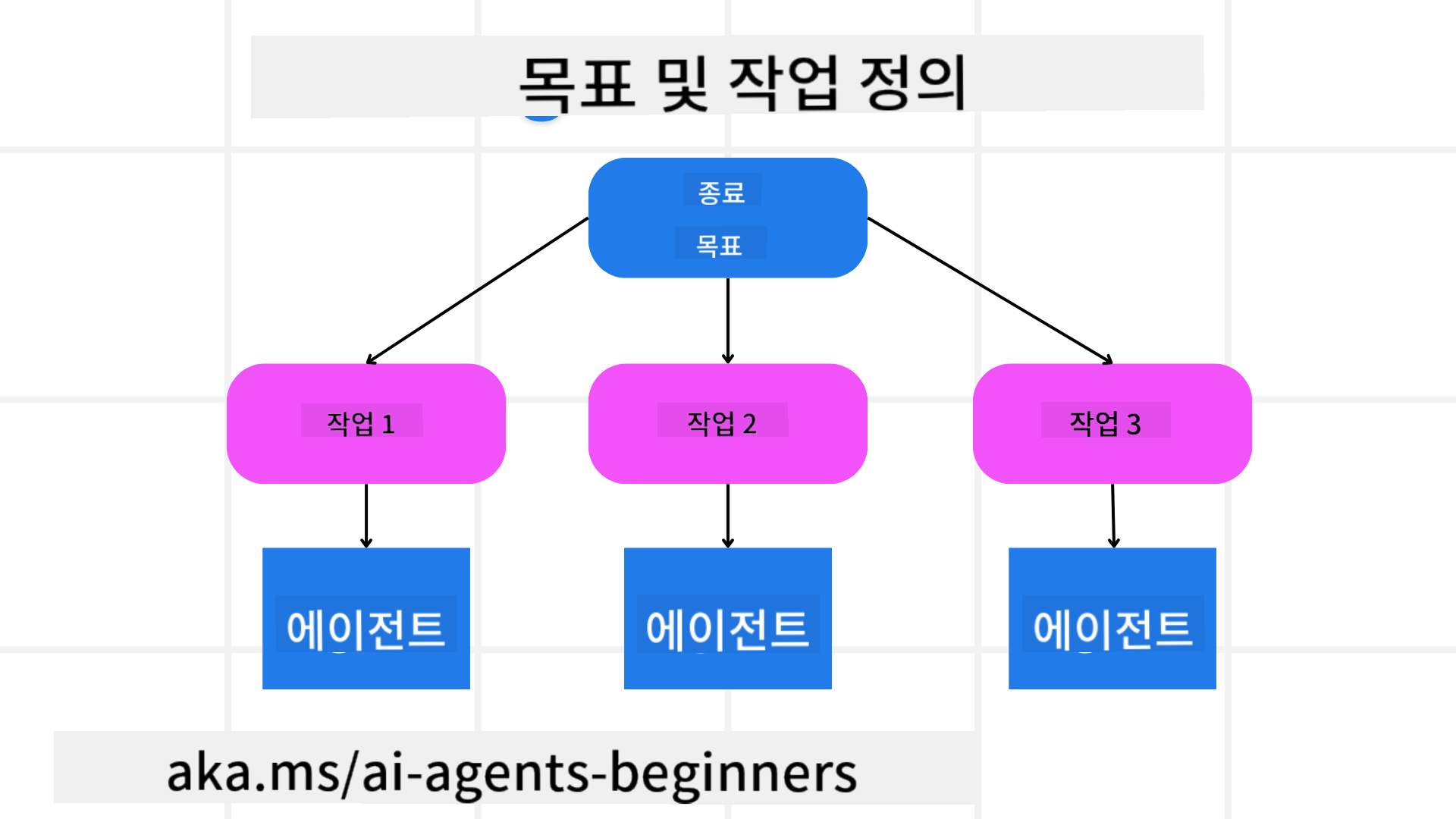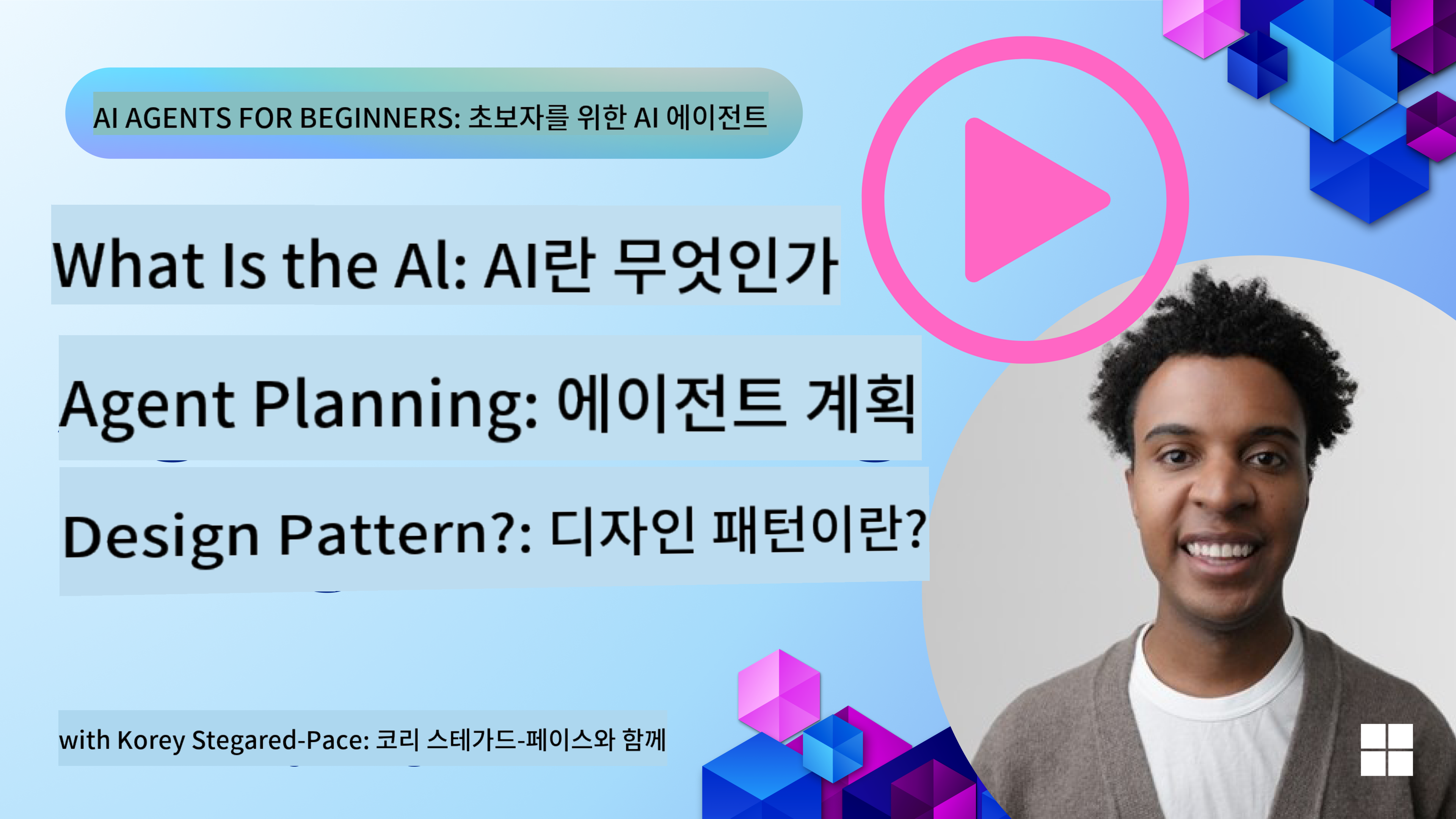ai-agents-for-beginners
(위 이미지를 클릭하면 이 강의의 영상을 볼 수 있습니다)
계획 설계
소개
이 강의에서는 다음 내용을 다룹니다:
- 명확한 전체 목표를 정의하고 복잡한 작업을 관리 가능한 작업으로 나누는 방법.
- 구조화된 출력을 활용하여 더 신뢰할 수 있고 기계가 읽을 수 있는 응답을 생성하는 방법.
- 이벤트 기반 접근 방식을 적용하여 동적 작업과 예상치 못한 입력을 처리하는 방법.
학습 목표
이 강의를 완료한 후, 다음에 대한 이해를 갖게 됩니다:
- AI 에이전트의 전체 목표를 식별하고 설정하여 무엇을 달성해야 하는지 명확히 알게 하기.
- 복잡한 작업을 관리 가능한 하위 작업으로 분해하고 이를 논리적인 순서로 조직화하기.
- 에이전트에게 적절한 도구(예: 검색 도구 또는 데이터 분석 도구)를 제공하고, 이를 언제 어떻게 사용할지 결정하며, 발생하는 예상치 못한 상황을 처리하기.
- 하위 작업 결과를 평가하고 성과를 측정하며, 최종 출력을 개선하기 위해 행동을 반복하기.
전체 목표 정의 및 작업 분해

대부분의 실제 작업은 한 단계로 해결하기에는 너무 복잡합니다. AI 에이전트는 계획과 행동을 안내할 간결한 목표가 필요합니다. 예를 들어, 다음 목표를 고려해 보세요:
"3일 여행 일정 생성하기."
이 목표는 간단히 표현할 수 있지만, 여전히 세부적으로 다듬어야 합니다. 목표가 명확할수록 에이전트(및 인간 협력자)가 올바른 결과를 달성하는 데 집중할 수 있습니다. 예를 들어, 항공편 옵션, 호텔 추천, 활동 제안이 포함된 포괄적인 일정을 만드는 것이 목표일 수 있습니다.
작업 분해
크거나 복잡한 작업은 더 작은 목표 지향적인 하위 작업으로 나누면 관리하기 쉬워집니다. 여행 일정 예제를 기준으로 목표를 다음과 같이 분해할 수 있습니다:
- 항공편 예약
- 호텔 예약
- 차량 대여
- 개인화
각 하위 작업은 전담 에이전트나 프로세스에 의해 처리될 수 있습니다. 한 에이전트는 최적의 항공편 거래를 검색하는 데 특화될 수 있고, 다른 에이전트는 호텔 예약에 집중할 수 있습니다. 그런 다음 조정 또는 “다운스트림” 에이전트가 이러한 결과를 하나의 통합된 일정으로 사용자에게 제공할 수 있습니다.
이 모듈식 접근 방식은 점진적인 개선도 가능하게 합니다. 예를 들어, 음식 추천이나 지역 활동 제안을 위한 전문 에이전트를 추가하고 일정의 품질을 시간이 지남에 따라 개선할 수 있습니다.
구조화된 출력
대규모 언어 모델(LLM)은 구조화된 출력(예: JSON)을 생성할 수 있으며, 이는 다운스트림 에이전트나 서비스가 구문 분석하고 처리하기에 더 용이합니다. 이는 계획 출력이 수신된 후 이러한 작업을 실행할 수 있는 다중 에이전트 환경에서 특히 유용합니다. 간단히 살펴보세요.
다음 Python 코드 스니펫은 목표를 하위 작업으로 분해하고 구조화된 계획을 생성하는 간단한 계획 에이전트를 보여줍니다:
from pydantic import BaseModel
from enum import Enum
from typing import List, Optional, Union
import json
import os
from typing import Optional
from pprint import pprint
from autogen_core.models import UserMessage, SystemMessage, AssistantMessage
from autogen_ext.models.azure import AzureAIChatCompletionClient
from azure.core.credentials import AzureKeyCredential
class AgentEnum(str, Enum):
FlightBooking = "flight_booking"
HotelBooking = "hotel_booking"
CarRental = "car_rental"
ActivitiesBooking = "activities_booking"
DestinationInfo = "destination_info"
DefaultAgent = "default_agent"
GroupChatManager = "group_chat_manager"
# Travel SubTask Model
class TravelSubTask(BaseModel):
task_details: str
assigned_agent: AgentEnum # we want to assign the task to the agent
class TravelPlan(BaseModel):
main_task: str
subtasks: List[TravelSubTask]
is_greeting: bool
client = AzureAIChatCompletionClient(
model="gpt-4o-mini",
endpoint="https://models.inference.ai.azure.com",
# To authenticate with the model you will need to generate a personal access token (PAT) in your GitHub settings.
# Create your PAT token by following instructions here: https://docs.github.com/en/authentication/keeping-your-account-and-data-secure/managing-your-personal-access-tokens
credential=AzureKeyCredential(os.environ["GITHUB_TOKEN"]),
model_info={
"json_output": False,
"function_calling": True,
"vision": True,
"family": "unknown",
},
)
# Define the user message
messages = [
SystemMessage(content="""You are an planner agent.
Your job is to decide which agents to run based on the user's request.
Provide your response in JSON format with the following structure:
{'main_task': 'Plan a family trip from Singapore to Melbourne.',
'subtasks': [{'assigned_agent': 'flight_booking',
'task_details': 'Book round-trip flights from Singapore to '
'Melbourne.'}
Below are the available agents specialised in different tasks:
- FlightBooking: For booking flights and providing flight information
- HotelBooking: For booking hotels and providing hotel information
- CarRental: For booking cars and providing car rental information
- ActivitiesBooking: For booking activities and providing activity information
- DestinationInfo: For providing information about destinations
- DefaultAgent: For handling general requests""", source="system"),
UserMessage(
content="Create a travel plan for a family of 2 kids from Singapore to Melboune", source="user"),
]
response = await client.create(messages=messages, extra_create_args={"response_format": 'json_object'})
response_content: Optional[str] = response.content if isinstance(
response.content, str) else None
if response_content is None:
raise ValueError("Response content is not a valid JSON string" )
pprint(json.loads(response_content))
# # Ensure the response content is a valid JSON string before loading it
# response_content: Optional[str] = response.content if isinstance(
# response.content, str) else None
# if response_content is None:
# raise ValueError("Response content is not a valid JSON string")
# # Print the response content after loading it as JSON
# pprint(json.loads(response_content))
# Validate the response content with the MathReasoning model
# TravelPlan.model_validate(json.loads(response_content))
다중 에이전트 오케스트레이션을 활용한 계획 에이전트
이 예제에서는 Semantic Router Agent가 사용자 요청(예: “여행을 위한 호텔 계획이 필요합니다.”)을 받습니다.
플래너는 다음을 수행합니다:
- 호텔 계획 수신: 플래너는 사용자의 메시지를 받고, 시스템 프롬프트(사용 가능한 에이전트 세부 정보 포함)를 기반으로 구조화된 여행 계획을 생성합니다.
- 에이전트 및 도구 목록 작성: 에이전트 레지스트리는 항공편, 호텔, 차량 대여, 활동 등을 위한 에이전트 목록과 그들이 제공하는 기능 또는 도구를 보유합니다.
- 계획을 해당 에이전트에 라우팅: 하위 작업 수에 따라 플래너는 메시지를 단일 작업 시나리오의 경우 전담 에이전트에 직접 보내거나 다중 에이전트 협업을 위해 그룹 채팅 관리자를 통해 조정합니다.
- 결과 요약: 마지막으로 플래너는 생성된 계획을 명확히 요약합니다.
다음 Python 코드 샘플은 이러한 단계를 보여줍니다:
from pydantic import BaseModel
from enum import Enum
from typing import List, Optional, Union
class AgentEnum(str, Enum):
FlightBooking = "flight_booking"
HotelBooking = "hotel_booking"
CarRental = "car_rental"
ActivitiesBooking = "activities_booking"
DestinationInfo = "destination_info"
DefaultAgent = "default_agent"
GroupChatManager = "group_chat_manager"
# Travel SubTask Model
class TravelSubTask(BaseModel):
task_details: str
assigned_agent: AgentEnum # we want to assign the task to the agent
class TravelPlan(BaseModel):
main_task: str
subtasks: List[TravelSubTask]
is_greeting: bool
import json
import os
from typing import Optional
from autogen_core.models import UserMessage, SystemMessage, AssistantMessage
from autogen_ext.models.openai import AzureOpenAIChatCompletionClient
# Create the client with type-checked environment variables
client = AzureOpenAIChatCompletionClient(
azure_deployment=os.getenv("AZURE_OPENAI_DEPLOYMENT_NAME"),
model=os.getenv("AZURE_OPENAI_DEPLOYMENT_NAME"),
api_version=os.getenv("AZURE_OPENAI_API_VERSION"),
azure_endpoint=os.getenv("AZURE_OPENAI_ENDPOINT"),
api_key=os.getenv("AZURE_OPENAI_API_KEY"),
)
from pprint import pprint
# Define the user message
messages = [
SystemMessage(content="""You are an planner agent.
Your job is to decide which agents to run based on the user's request.
Below are the available agents specialized in different tasks:
- FlightBooking: For booking flights and providing flight information
- HotelBooking: For booking hotels and providing hotel information
- CarRental: For booking cars and providing car rental information
- ActivitiesBooking: For booking activities and providing activity information
- DestinationInfo: For providing information about destinations
- DefaultAgent: For handling general requests""", source="system"),
UserMessage(content="Create a travel plan for a family of 2 kids from Singapore to Melbourne", source="user"),
]
response = await client.create(messages=messages, extra_create_args={"response_format": TravelPlan})
# Ensure the response content is a valid JSON string before loading it
response_content: Optional[str] = response.content if isinstance(response.content, str) else None
if response_content is None:
raise ValueError("Response content is not a valid JSON string")
# Print the response content after loading it as JSON
pprint(json.loads(response_content))
이전 코드의 출력은 다음과 같으며, 이를 assigned_agent로 라우팅하고 최종 사용자에게 여행 계획을 요약하는 데 사용할 수 있습니다.
{
"is_greeting": "False",
"main_task": "Plan a family trip from Singapore to Melbourne.",
"subtasks": [
{
"assigned_agent": "flight_booking",
"task_details": "Book round-trip flights from Singapore to Melbourne."
},
{
"assigned_agent": "hotel_booking",
"task_details": "Find family-friendly hotels in Melbourne."
},
{
"assigned_agent": "car_rental",
"task_details": "Arrange a car rental suitable for a family of four in Melbourne."
},
{
"assigned_agent": "activities_booking",
"task_details": "List family-friendly activities in Melbourne."
},
{
"assigned_agent": "destination_info",
"task_details": "Provide information about Melbourne as a travel destination."
}
]
}
이전 코드 샘플이 포함된 예제 노트북은 여기에서 확인할 수 있습니다.
반복 계획
일부 작업은 하위 작업의 결과가 다음 작업에 영향을 미치는 경우 재계획 또는 반복이 필요합니다. 예를 들어, 에이전트가 항공편 예약 중 예상치 못한 데이터 형식을 발견하면 호텔 예약으로 넘어가기 전에 전략을 조정해야 할 수 있습니다.
또한 사용자 피드백(예: 사용자가 더 이른 항공편을 선호한다고 결정하는 경우)은 부분적인 재계획을 유발할 수 있습니다. 이러한 동적이고 반복적인 접근 방식은 최종 솔루션이 실제 제약 조건과 변화하는 사용자 선호도에 맞도록 보장합니다.
예: 샘플 코드
from autogen_core.models import UserMessage, SystemMessage, AssistantMessage
#.. same as previous code and pass on the user history, current plan
messages = [
SystemMessage(content="""You are a planner agent to optimize the
Your job is to decide which agents to run based on the user's request.
Below are the available agents specialized in different tasks:
- FlightBooking: For booking flights and providing flight information
- HotelBooking: For booking hotels and providing hotel information
- CarRental: For booking cars and providing car rental information
- ActivitiesBooking: For booking activities and providing activity information
- DestinationInfo: For providing information about destinations
- DefaultAgent: For handling general requests""", source="system"),
UserMessage(content="Create a travel plan for a family of 2 kids from Singapore to Melbourne", source="user"),
AssistantMessage(content=f"Previous travel plan - {TravelPlan}", source="assistant")
]
# .. re-plan and send the tasks to respective agents
더 포괄적인 계획을 위해 Magnetic One를 확인해 보세요.
요약
이 글에서는 사용 가능한 에이전트를 동적으로 선택할 수 있는 플래너를 생성하는 방법의 예를 살펴보았습니다. 플래너의 출력은 작업을 분해하고 에이전트를 할당하여 실행할 수 있도록 합니다. 에이전트가 작업을 수행하는 데 필요한 기능/도구에 접근할 수 있다고 가정합니다. 에이전트 외에도 반영, 요약, 라운드 로빈 채팅과 같은 다른 패턴을 포함하여 맞춤화할 수 있습니다.
추가 자료
AutoGen Magnetic One - 복잡한 작업을 해결하기 위한 범용 다중 에이전트 시스템으로, 여러 어려운 에이전트 벤치마크에서 인상적인 결과를 달성했습니다. 참고:
. 이 구현에서는 오케스트레이터가 작업별 계획을 생성하고 이러한 작업을 사용 가능한 에이전트에 위임합니다. 오케스트레이터는 계획뿐만 아니라 작업 진행 상황을 모니터링하고 필요에 따라 재계획하는 추적 메커니즘도 사용합니다.
계획 설계 패턴에 대해 더 궁금한 점이 있으신가요?
Azure AI Foundry Discord에 참여하여 다른 학습자들과 만나고, 오피스 아워에 참석하며 AI 에이전트에 대한 질문에 답변을 받을 수 있습니다.
이전 강의
다음 강의
면책 조항:
이 문서는 AI 번역 서비스 Co-op Translator를 사용하여 번역되었습니다. 정확성을 위해 최선을 다하고 있지만, 자동 번역에는 오류나 부정확성이 포함될 수 있습니다. 원본 문서의 원어 버전을 권위 있는 출처로 간주해야 합니다. 중요한 정보의 경우, 전문적인 인간 번역을 권장합니다. 이 번역 사용으로 인해 발생하는 오해나 잘못된 해석에 대해 책임을 지지 않습니다.
